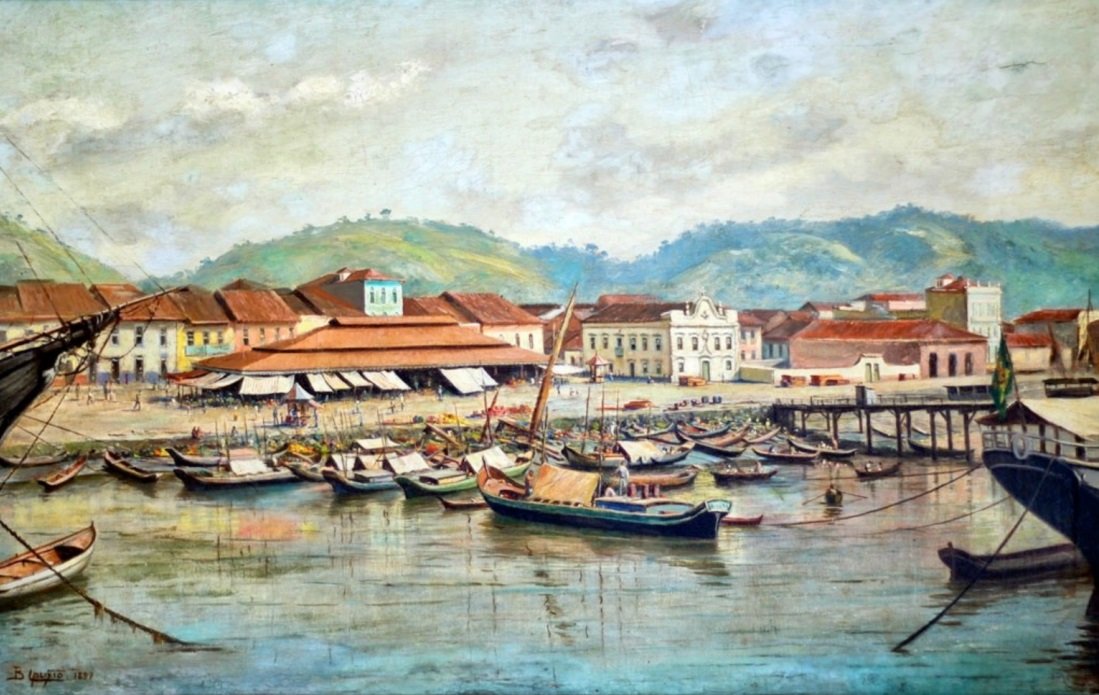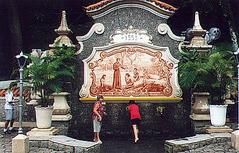
Comprehensive Guide to Visiting Centro, Cubatão, Brazil
Date: 17/08/2024
Introduction
Centro, Cubatão, located in the São Paulo state of Brazil, is a fascinating blend of historical significance, cultural richness, and industrial achievements. Renowned for its pivotal role in Brazil’s trade and transportation history, Cubatão has evolved from ancient indigenous settlements to a modern industrial hub. This guide aims to provide a comprehensive overview of Centro, Cubatão, covering its historical background, key attractions, visitor information, and practical travel tips. Whether you’re interested in exploring historical sites, understanding the city’s economic transformation, or simply enjoying local cuisine, this guide has you covered. The city’s rich history is evidenced by the early habitation of the “Homem do Sambaqui” around 7,000 years ago, and it continued to play a significant role during the colonial era with the establishment of the Porto Geral de Cubatão in the 18th century (Wikipedia, Planejando Viagens). Today, Cubatão is a vibrant destination with a mix of historical landmarks, cultural attractions, and natural beauty, making it an ideal spot for travelers seeking a diverse and enriching experience.
Table of Contents
- Introduction
- Historical Background
- Significance of Centro, Cubatão, Brazil
- Environmental Challenges and Initiatives
- Visitor Information
- FAQ
- Conclusion
Historical Background
Early Settlement and Indigenous Presence
Cubatão’s history dates back thousands of years, with archaeological evidence suggesting habitation by the “Homem do Sambaqui” (Shell Mound Man) around 7,000 years ago. These early inhabitants were semi-nomadic groups who relied on the mangrove ecosystems for their subsistence, utilizing resources such as crabs, bivalve shells, and fish. They developed a unique culture characterized by the manufacture of mixed stone and organic tools, including polished stone tools and various adornments (Wikipedia).
Colonial Era and Jesuit Influence
The first recorded mention of Cubatão dates back to 1533 when Martim Afonso de Souza, the donatary of the Captaincy of São Vicente, granted part of the land to Rui Pinto. This period marked the beginning of European influence in the region. Jesuits, merchants, and other colonial authorities frequently passed through Cubatão as they traveled from the coastal areas to the interior plateau. The region became a crucial passageway, first along water routes and later through the Perequê River Valley and the Serra do Mar.
Significance of Centro, Cubatão, Brazil
Historical Significance
Centro, Cubatão, holds a rich historical significance that dates back to the early 18th century. The area was initially a pivotal point for trade and transportation. The Porto Geral de Cubatão was established in the first half of the 18th century and became a crucial hub where goods were transferred from river barges to mule trains that ascended the Serra do Mar. This port facilitated the movement of goods from the coastal regions to the interior, playing a vital role in the economic activities of the time (Planejando Viagens).
The significance of Centro, Cubatão, is further highlighted by the accounts of travelers like the Englishman William Henry May, who visited the area in 1810. His observations provide a glimpse into the bustling activities and the strategic importance of Cubatão during that period. Despite its early prominence, the area experienced stagnation after being annexed to Santos between 1833 and 1841, only to witness a resurgence in the 20th century (Planejando Viagens).
Economic Development
The economic landscape of Centro, Cubatão, transformed significantly in the 20th century. The construction of the Via Anchieta in the 1940s marked a turning point, enhancing transportation links between São Paulo and the Baixada Santista. This development attracted major industrial projects, including the Refinaria Presidente Bernardes in 1955 and the Companhia Siderúrgica Paulista (Cosipa) in 1959. These industries spurred economic growth and led to the political emancipation of Cubatão from Santos on January 1, 1949 (Planejando Viagens).
Cultural and Tourist Attractions
Centro, Cubatão, offers a variety of cultural and historical attractions that provide insights into its rich heritage. One notable site is the Marco Padrão de São Vicente, a monument commemorating the landing of Portuguese sailor Martim Afonso de Souza in 1532. This site marks the establishment of the first city in Portuguese America (Komoot).
Another significant attraction is the Ponte Pênsil de São Vicente, one of Brazil’s first suspension bridges. This historical structure connects São Vicente Island to the mainland and is accessible to pedestrians and cyclists, offering scenic views and a glimpse into the engineering marvels of the past (Komoot).
For sports enthusiasts, the Pelé Museum in nearby Santos is a must-visit. Dedicated to the legendary football player Pelé, the museum houses an extensive collection of memorabilia, trophies, and photographs that chronicle his illustrious career (Komoot).
Environmental Challenges and Initiatives
The rapid industrialization of Centro, Cubatão, has led to significant environmental challenges. The concentration of industries without adequate planning resulted in severe pollution issues. By the 1980s, Cubatão was infamously known as one of the most polluted cities in the world. Efforts to address these issues have been ongoing, with various initiatives aimed at reducing pollution and improving environmental quality (Planejando Viagens).
One of the key measures has been the implementation of stricter environmental regulations and the adoption of cleaner technologies by industries. These efforts have led to noticeable improvements in air and water quality, although challenges remain. The local government continues to work with industries and environmental organizations to promote sustainable development and ensure a better quality of life for residents (Planejando Viagens).
Visitor Information
Visiting Hours and Tickets
When planning your visit to Centro, Cubatão, it’s essential to know the visiting hours and ticket information for major attractions:
- Marco Padrão de São Vicente: Open daily from 8:00 AM to 6:00 PM. Entry is free.
- Ponte Pênsil de São Vicente: Open 24 hours. Accessible to pedestrians and cyclists without any charge.
- Pelé Museum: Open Tuesday to Sunday from 10:00 AM to 6:00 PM. Tickets cost approximately $5 for adults and $2.50 for children and seniors.
Transportation
The Via Anchieta provides easy access to Cubatão from São Paulo and other parts of the Baixada Santista. Public transportation options, including buses and taxis, are available for getting around the city.
Accommodation
While Cubatão has a range of accommodation options, visitors may also consider staying in nearby Santos, which offers a wider selection of hotels and amenities.
Local Cuisine
Cubatão boasts a variety of dining options, with local restaurants offering traditional Brazilian dishes. Seafood is particularly popular, given the city’s proximity to the coast.
Safety
As with any urban area, visitors should take standard safety precautions, such as avoiding poorly lit areas at night and keeping an eye on personal belongings.
FAQ
Q: What are the best times to visit Centro, Cubatão?
A: The best times to visit are during the cooler months from May to September when the weather is more comfortable for sightseeing.
Q: Are there guided tours available in Centro, Cubatão?
A: Yes, several local tour operators offer guided tours that cover historical sites and industrial landmarks.
Q: Is Centro, Cubatão accessible for people with disabilities?
A: Some attractions have made efforts to improve accessibility, but it’s advisable to check specific sites in advance for detailed accessibility options.
Conclusion
Centro, Cubatão is a destination that offers a unique blend of history, culture, and industrial significance. From its early indigenous settlements and colonial era developments to its modern-day industrial achievements, Cubatão provides a rich tapestry of experiences for visitors. The city’s historical significance is highlighted by landmarks such as the Marco Padrão de São Vicente and the Ponte Pênsil de São Vicente, while its economic transformation is marked by the establishment of major industrial projects in the 20th century (Planejando Viagens, Komoot). Despite facing environmental challenges, Cubatão’s resilience and ongoing efforts towards sustainable development make it a fascinating place to visit. Whether you’re exploring historical sites, enjoying local cuisine, or learning about the city’s industrial heritage, Centro, Cubatão promises a memorable and enriching experience. As you plan your visit, remember to take advantage of the practical tips and visitor information provided in this guide to ensure a safe and enjoyable trip. For more travel tips and updates, don’t forget to download our mobile app Audiala and follow us on social media.
References
- Wikipedia. (n.d.). História de Cubatão. Retrieved from https://pt.wikipedia.org/wiki/Hist%C3%B3ria_de_Cubat%C3%A3o
- Planejando Viagens. (n.d.). Cubatão: Significado e História de um Caminho de Desenvolvimento. Retrieved from https://planejandoviagens.com.br/cubatao-significado-historia-de-um-caminho-de-desenvolvimento/
- Komoot. (n.d.). Attractions in Cubatão. Retrieved from https://www.komoot.com/guide/3054928/attractions-in-cubatao

